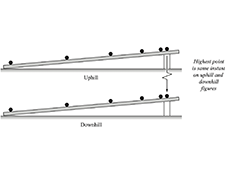
Acceleration in one-dimension
Variant i Dynamics first Other Variants Conservation laws first, Interactive tutorial lecture
The tutorial covers vector addition and subtraction in one dimension,the idea of change-in-velocity as a directed quantity, an operational definition for acceleration, and the idea of limits.
Topics Mechanics / Kinematics: graphs, idealizations, limits, operational definitions, rates of change, representations, vectors, acceleration, acceleration vs. velocity, change in velocity, kinematics, object on ramp, slopes of graphs, and vector addition & subtraction
Materials
Materials by the UW team
- Instructor Guide


- Pretest


- Exam Questions



- Equipment List

Materials from others
- Instructor Notes (S. Pollock)


Tutorial details
In this tutorial and the next, students are given practice in vector addition and subtraction and guidance in applying the operational definition of acceleration to specific situations. The tutorial tasks are very similar to the questions asked in the first part of the pretest. Questions guide students in drawing vectors for the velocity of a ball moving up an incline. They place vectors for two instants side-by-side, draw the vector that must be added to the earlier velocity to obtain the later velocity, and are asked why the name “change in velocity” is appropriate for this vector.
Students then consider how the change in velocity vector depends on the time interval. Based on prior observations of the motion of a ball on an incline or on an v versus t graph given in the worksheet, they recognize that the change in velocity is proportional to the time. They conclude that the acceleration is constant and directed down the track while the ball moves up the track.
Students repeat the reasoning discussed above for the motion of a ball moving down the track and for motion near the turnaround. Many students are surprised to find that the acceleration is not zero at the top of the trajectory.
Finally, students generalize their results. They realize that the acceleration is in the same direction as the velocity for an object that is speeding up and in the opposite direction for an object that is slowing down.
For instruction tips, login or register as a verified educator to see the Instructor Guide.
Prerequisites
Prerequisite tutorials
The Velocity and Representations of motion tutorials are prerequisites to Acceleration in one-dimension.
Other prerequisites
The tutorial requires minimal background of the students. It is assumed that vectors have been introduced in class and that velocity and acceleration have been defined. (See the tutorials Velocity and Representations of motion.) It is also expected, but not required, that students have made the observation that an object on an incline has constant acceleration.
Research
- P. Shaffer and L. McDermott, A research-based approach to improving student understanding of the vector nature of kinematical concepts, Am. J. Phys. 73 (10), 921 (2005).
- D. Trowbridge and L. McDermott, Investigation of student understanding of the concept of velocity in one dimension, Am. J. Phys. 48 (12), 1020 (1980).
- D. Trowbridge and L. McDermott, Investigation of student understanding of the concept of acceleration in one dimension, Am. J. Phys. 49 (3), 242 (1981).
Coming Soon! We hope to release the discussion section on each tutorial soon.

